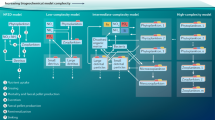Abstract
This chapter provides a short introduction to the most commonly used numerical methods in computational fluid dynamics, and some specific aspects of numerical modelling of ocean currents. When working with numerical models, it is essential to have a basic understanding of the possibilities and limitations of the modelling toolbox. The first part gives a demonstration on how the model differential equations for fluid motions can be transformed into computer code instructions. Important concepts such as consistency, stability and convergence are discussed. The second part of the chapter provides an introduction to ocean modelling, with emphasis on the approximations that are commonly used in general circulation models.
Access this chapter
Tax calculation will be finalised at checkout
Purchases are for personal use only
Similar content being viewed by others
Notes
- 1.
In Eq. (3.5) the expression f (j)(x 0) indicates the j-th derivative of the function f, not to be confused with the discretization notation f (n).
- 2.
The ‘Big O’ notation describes the limiting behaviour of a function f by comparing it to the behaviour of a simpler function g. Therefore, if
$$\lim_{x \rightarrow x_0} \frac{f(x)}{g(x)} = C $$where C is some finite number, then \(f(x) = \mathcal{O}(g(x))\) as x→x 0. When discussing finite difference schemes it is implicitly understood that the approximation is valid for Δx→0, and therefore this condition is usually not stated explicitly in the formulas.
- 3.
Note that the rotation of the Earth is not a driving force in itself. When Newton’s laws of motion are applied in a rotating frame of reference, motion along a straight line appears to be deflected to the left or right. The Coriolis and centrifugal forces are introduced to account for such deflections. These forces are often called inertial forces or fictitious forces in order to emphasize that they are not connected to any physical force, but to the acceleration of the rotating system itself.
- 4.
GFDL Modular Ocean Model, http://www.gfdl.noaa.gov/ocean-model.
- 5.
M.I.T. general circulation model, http://mitgcm.org/.
- 6.
Princeton Ocean Model, http://aos.princeton.edu/WWWPUBLIC/htdocs.pom/.
- 7.
Regional Ocean Modeling System, http://www.myroms.org/.
- 8.
Miami Isopycnic Coordinate Ocean Model.
- 9.
Navy Layered Ocean Model, http://www7320.nrlssc.navy.mil/global_nlom/.
- 10.
HYbrid Coordinate Ocean Model, http://hycom.org/.
- 11.
Finite Volume Coastal Ocean Model, http://fvcom.smast.umassd.edu/FVCOM/.
References
Anderson JD Jr (1995) Computational fluid dynamics: the basics with applications. McGraw-Hill, New York
Benestad RE, Hanssen-Bauer I, Chen D (2008) Empirical–statistical downscaling. World Scientific, Singapore
Ferziger JF, Perić M (2002) Computational methods for fluid dynamics, 3rd edn. Springer, Berlin
Haidvogel DB, Beckmann A (1999) Numerical ocean circulation modeling. Imperial College Press, London
Johnson C (2009) Numerical solution of partial differential equations by the finite element method. Dover, New York
Joint Panel on Oceanographic Tables and Standards [JPOTS] (1991) Processing of oceanographic station data. Unesco, Paris. ISBN 9231027565/9789231027567
LeVeque RJ (2002) Finite volume methods for hyperbolic problems. Cambridge University Press, Cambridge
Monaghan JJ (2012) Smoothed particle hydrodynamics and its diverse applications. Annu Rev Fluid Mech 44:323–346
Reynolds O (1883) An experimental investigation of the circumstances which determine whether the motion of water shall be direct or sinuous, and the law of resistance in parallel channels. Philos Trans R Soc Lond Ser A 174:935–982
Thomas JW (1995) Numerical partial differential equations: finite difference methods. Springer, Berlin
Thorpe SA (2007) An introduction to ocean turbulence. Cambridge University Press, Cambridge
Acknowledgements
This work, originally motivated by the BONUS project BalticWay, was supported by the European Union through the Mobilitas grant MTT63 and through support to the Estonian Centre of Excellence for Non-linear Studies (CENS) from the European Regional Development Fund, and by targeted financing by the Estonian Ministry of Education and Research (grant SF0140007s11).
Author information
Authors and Affiliations
Corresponding author
Editor information
Editors and Affiliations
Rights and permissions
Copyright information
© 2013 Springer International Publishing Switzerland
About this chapter
Cite this chapter
Torsvik, T. (2013). Introduction to Computational Fluid Dynamics and Ocean Modelling. In: Soomere, T., Quak, E. (eds) Preventive Methods for Coastal Protection. Springer, Heidelberg. https://doi.org/10.1007/978-3-319-00440-2_3
Download citation
DOI: https://doi.org/10.1007/978-3-319-00440-2_3
Publisher Name: Springer, Heidelberg
Print ISBN: 978-3-319-00439-6
Online ISBN: 978-3-319-00440-2
eBook Packages: Mathematics and StatisticsMathematics and Statistics (R0)




